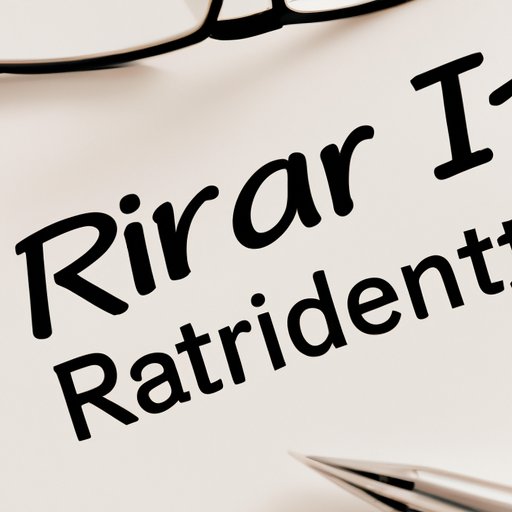
Introduction
Retirement planning is a vital part of financial stability. While it is easy to delay thinking about the future, the earlier you start planning, the better off you will be when you retire. One of the most important tools in preparing for retirement is an individual retirement account, or IRA. In this article, we will cover the basic steps of opening an IRA and what you need to do to get started.
Step 1: Understand the Basics of an IRA
An IRA is a tax-advantaged investment account designed to help you save for retirement. You can contribute pre-tax dollars, and your contributions and any earnings are tax-deferred until you withdraw them, usually after retirement. There are two main types of IRA accounts: Traditional and Roth IRAs.
A traditional IRA allows you to deduct the amount of your contribution from your taxes, and your contributions grow tax-deferred over time. When you withdraw money from your account in retirement, you pay taxes on your withdrawals at your income tax rate.
A Roth IRA, on the other hand, does not give you a tax deduction upfront, but your contributions and earnings grow tax-free. When you withdraw money from your account in retirement, it’s usually tax-free.
To be eligible to contribute to an IRA, you must have taxable income from a job or business for the year, and you must be under the age of 70 ½. There are other requirements, such as income limits, that you should discuss with your financial advisor.
Step 2: Choose the Right IRA for Your Needs
Deciding which IRA account to contribute to depends on your individual circumstances. A traditional IRA is a great option if you expect to be in a lower tax bracket when you retire than you are now, as contributions will be deductible at a higher tax rate and taxed at a lower rate later on. A Roth IRA may be a better option if you expect your tax rate to be the same or higher in retirement than it is now. Additionally, since Roth IRA contributions are not tax-deductible, they’re more appropriate for people who don’t need the immediate tax break.
The best approach is to assess your current tax situation, your future retirement goals, your investment horizon and risk tolerance, and work with an experienced financial advisor to help you determine which IRA account is best for you.
Step 3: Select a Provider and Open an Account
When selecting an IRA provider, it’s essential to shop around. There are many providers, and each has different eligibility requirements, fees, and features. Look for a provider that has low fees, easy-to-use technology, excellent customer support, and an excellent reputation for reliability.
To open an account, you will need to provide basic information, such as your name, Social Security number, and birthdate. Additionally, you will need to provide information on what type of IRA you want to open, the amount you wish to contribute, and how you will fund the account.
Many IRA providers will allow you to fund your account by mailing a check, setting up an electronic transfer from your bank, or rolling over an existing retirement account. Be sure to review fees associated with opening and maintaining your account before completing your application.
Step 4: Fund Your IRA
After opening your IRA, you’ll need to fund it. IRA contribution limits are adjusted annually, so check the IRS website for the current contribution limits. For the 2021 tax year, the annual contribution limit is $6,000, with an additional $1,000 catch-up contribution if you’re over age 50.
It’s essential to contribute consistently and avoid missing deadlines. You typically have until the tax deadline to contribute to an IRA for the previous calendar year. However, it’s also good to set up regular contributions to your account throughout the year. By doing so, you’ll spread out the contributions, and it will be less of a financial burden. Your IRA provider can help you set up automatic contributions.
Step 5: Manage Your IRA
Your IRA requires some management to ensure that it’s performing well, and you’re on track for your retirement goals. It’s essential to monitor your account regularly and keep it up to date as your goals and financial situation change.
It’s important to know the tax implications of your IRA account. Traditional IRAs are subject to required minimum distributions (RMDs) beginning at the age of 72. Roth IRAs do not have RMDs. When you withdraw from a traditional IRA account, the money is taxed at your current tax rate. Understanding these tax implications will help you make smart decisions regarding your IRA.
Maximizing the benefits of your IRA requires discipline, consistency, and a long-term perspective. By staying invested, avoiding fees, and making regular contributions, your IRA account value can increase dramatically over time, and you can have a comfortable retirement.
Conclusion
Retirement planning is essential to ensure that you can live comfortably when you’re no longer working. One of the most important steps to prepare for retirement is opening an IRA account. Follow these steps to establish and maintain your IRA account effectively. Remember to consult with a financial advisor to ensure that you choose the right IRA account for your situation, and that your account is managed correctly for your retirement goals.
Don’t wait any longer to plan for your future. Start the process of opening an IRA account today.





